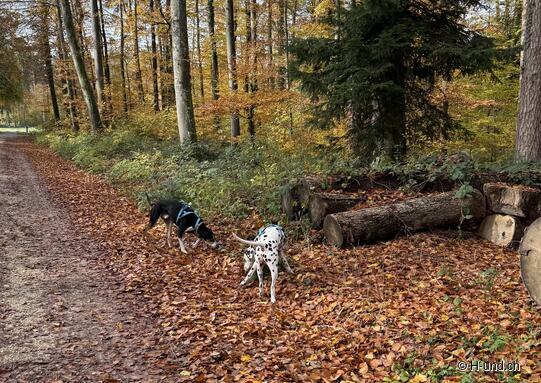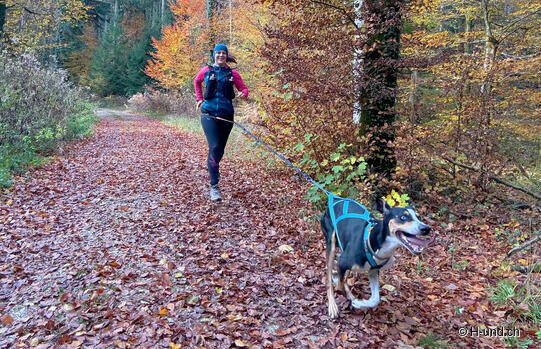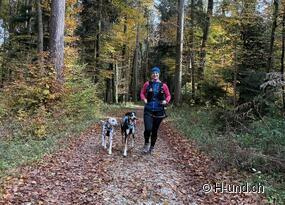Winter fit with a dog - healthy, active, happy
The days are getting shorter, the temperatures are dropping - and many people are still hanging on to the warm summer days. But even in winter, there are great ways to stay active with your dog! We'll show you the best way to prepare, what you should look out for and why dog walking is an exciting winter activity for both humans and dogs.
Winter as team time
Get strong indoors - indoor exercises for body and mind
After an active summer with hikes, walks or dog sports, your dog's condition is usually well built up - a perfect starting point for the winter.
There's no reason to take a break during the cold season! Dogs with thicker coats and undercoats in particular really come into their own in cooler temperatures.
Especially when it's raining or storming outside, it's the ideal time to work on coordination and muscle development. Well-developed muscles protect your dog from injury, stabilize their joints and support them in sporting activities such as agility or pulling.
Coordination exercises also promote body awareness, balance and alertness - perfect for training together and having fun.
Older dogs in particular benefit from targeted muscle development: with stronger muscles and better balance, they can move more safely, compensate for slips and reduce joint strain.
💡 Tip: Ask a dog physiotherapist to show you suitable exercises. An annual check-up - 3-4 times a year for very active dogs - helps to detect tension and imbalances at an early stage.

Warm-up & cool-down - the be-all and end-all for healthy exercise
Whether it's a snowshoe tour, mantrailing or dog training: warming up is also a must in winter. Even if your dog has been sitting in a warm car (make sure he is warm), he is not yet ready for exercise. Muscles and joints must be prepared in order to avoid injuries.

Warming up made easy
Start your training with a calm run-in where the dog can move freely and loosen up (not just 2 minutes!). After this, gentle mobilization exercises help to prepare the body for activity. Ideally, the start of a training session or an outing with a dog should be calm and relaxed. Rituals ensure calm and concentration - a clear start also helps your dog to stay focused. If the dog is already tense and excited when it gets out of the car, its muscles will also tense up and that is not what we want.
💡 Tip: Establish a ritualized warm-up program, for example, that the dog knows at some point. Rituals give security, security gives calm and you can start your activity relaxed, no matter what it looks like.
Typical warm-up exercises:
- Circling: Dog turns slowly 2-3 times to the left and right.
- Change positions: sit - down - stand alternately.
- Stroking: Run your hands evenly over the body to promote blood circulation and relaxation.
💧 Don't forget: even in winter, your dog needs water regularly - especially during intensive sports such as pulling.


After training, a slow cool-down is just as important.
A short walk, light stroking and access to water help to relax muscles and promote regeneration. Again, it is ideal if the dog can run out for a short walk and has access to water. As the owner, you can use this time to brush out the dog and check its paws. You will also notice how warm the dog effectively still is and can decide accordingly how long the cool-down should last. The same exercises can be used for the cool-down as for the warm-up. Stroking the dog can promote regeneration.

💡 Tip: A joint cool-down ritual also ensures a harmonious finish and strengthens your bond. Only put a coat on your dog when he is no longer overheated. That way he can really cool down.
Winter adventure: discover the sport of pulling dogs
Dog pulling is the classic winter activity - and far more versatile than many people think! The dog wears a special pulling harness and is connected to the human/bike/scooter/sled via an elastic leash with a shock absorber.

Variants of the pulling dog sport
- Canihike: You love hiking and you like to have your hands free. You can harness the dog with an appropriate harness around the hips and the dog runs ahead. The pace is irrelevant, but the dog has a task - to run ahead - and you have your hands free.
- Canicross: For the fast runners among you. If you are a sprinter, you will run even faster with a dog pulling you. However, with canicross the focus is on short distances up to approx. 4-7 km, with a correspondingly faster pace.
- Canitrail: If you enjoy running on longer trails, then the combination of dog pulling and trail running is ideal for you. Here you can cover distances up to the marathon distance (and even further for some). The pace here is not as fast as in canicross, the focus is on endurance.
- Bikejöring/Scooter: You prefer to travel on wheels, you don't mind high speeds and your dog has a lot of pulling power. Then dog pulling with a bike or scooter is ideal for you and your dog. The dog pulls the vehicle, it tends to be over shorter distances of 4-7 km and the speed is correspondingly high.
- Sled/wagon: If you have several dogs of similar strength, you can harness a whole team of 4 or more dogs to the sled or wagon and race through the woods.
- Cross-country skiing: Why go cross-country skiing alone when you can do it with your four-legged friend? There are various designated trails where dogs are also allowed, so you can hit the slopes together!
Dog training strengthens team spirit, muscles and stamina - and is a lot of fun!

You should keep this in mind
- Your dogs should be at least 12-18 months old and free of medical conditions. Dogs with restricted breathing in particular should not be used for pulling dog sports. A prior check-up by a vet or physiotherapist is highly recommended and mandatory for the fast-paced and very long variants. The size and therefore the pulling power of your dog is also decisive in determining which variant is right for you. With Canihike, Canitrail and Canicross, the size of the dog is basically irrelevant; even small dogs can be great partners in pulling dog sports. However, with scooters, bikes and carts in particular, it is important that the dogs are of a certain size and have strong pulling power, as the weight of the vehicle and the rider is even greater.
- Another important point is the equipment: the pulling harness for the dog must fit well. It is therefore not advisable to order one online without knowing what fits your dog. There are various well-equipped specialist stores with staff who are well versed in the sport of pulling dogs. It is therefore highly recommended to buy the equipment directly on site to ensure that everything fits properly.

How to get started
Try it out - harness your dog on a walk and watch how he reacts.
Some dogs pull on their own, others have to learn first. If you are planning to do canicross or bikejoring regularly, it is worth taking an introductory course to gradually and healthily introduce your dog to the task.
Conclusion: Strong together through the winter
Winter is not a time of rest - on the contrary!
With targeted muscle training, good warm-up and cool-down rituals and new challenges such as dog pulling, your dog will stay fit, healthy and motivated.
Whether on a walk, training or snowshoe tour - enjoy your time together outside and discover how much fun exercise can be in winter

Contribution from Andrea Norinelli/Physiotherapist Animactive




